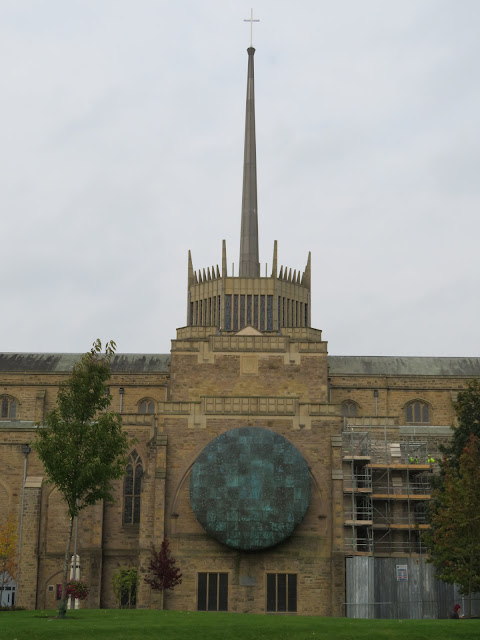Once moored up and fed and watered we went off to explore the city. It was an easy walk down hill to the centre around the Cathedral.
The cathedral is a bit of an amalgam of churches as it was originaly the parish church of St Mary the Virgin. This church had been built in 1826 replacing a previous church that had fallen into disrepair. There had been a church on this site for more than a thousand years, and the first stone building from Norman times. In 1926 the Diocese of Blackburn was created out of that of Manchester and the parish church was made a cathedral. This church is now actually the nave of the current building. Fund raising started and by 1938 enough was saved to start building. WWII got in the way and money was tight so plans had to be altered. The church's distinctive lantern tower was completed in 1967 but it was 1977 that the cathedral was fully finished and consecrated then.
The high altar has the corona above to represent the crown of thorns. The lantern tower is above and had to be virtually rebuilt in 1998 and further work to the roof had to be carried out in 2000/01 and it is really only after this that the Cathedral was felt to be truly completed.
At the opposite end to the altar is the 13' aluminium and black iron sculpture by John Hayward called 'Christ the Worker' and it a real focal point of the light and airy church nave.
The lantern tower can be seen from the outside. The church is home to many modern pieces of art that really gives this newest cathedral in England.
This is the old town hall and it started to be built in 1852 and was finally completed in 1856 and included assembly rooms, council chambers and offices, and also the police cells and offices until 1873.
Inside the entrance wer a set of beautiful tiles, these representing science and labour.
A little further up the road is the museum and art gallery. Unfortunately it has very limited opening and today was not a lucky one for us. The carvings on the exterior are superb and this one seems to be concerned with science and engineering. It was one of the first purpose built free to visit museums in the country when built in 1871.
Not 100% sure what helen was gurning at but this statue of William Henry Hornby was erected in 1912 and this is the second place it has been positioned. It is not the block who started the Hornby Model Railway company but the first Mayor of Blackburn in 1951. I thought it was brand new or made of non stick plastic as it was spotlessly clean. No bird has obviously been brave enough to defile the image!
Blackburn seems to have many more modern sculptures dotted around and these on Church Street represent the growth of the cotton plant along with the growth of Blackburn.
The Old Blackburn Bank was erected at times when there were cotton riots in the town, around 1878, and it was built to show dependence and reassurance. May be that is also the reason it has a massive gate and very high windows?
Opposite the Old Bank is another modern piece called the Woven Globe that was commissioned for the Millennium and with an almost twin in Darwen nearby. The white buildings are pavilions that were built in 1835. They became dilapidated but once restored they were connected by the glassed areas and are in use once again.
The rest of our visit will have to be for another day.
AS IT IS WORLD MARITIME DAY TODAY, PLEASE SPARE A THOUGHT FOR ALL THOSE AWAY FROM HOME ON THE HIGH SEAS BRING GOODS AND COMMODITIES TO EVERYBODY AROUND THE WORLD. WHERE WOULD WE BE WITHOUT THEM.











No comments:
Post a Comment